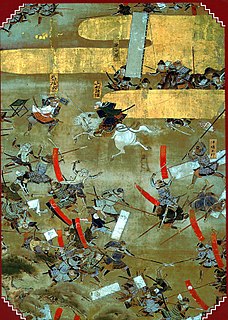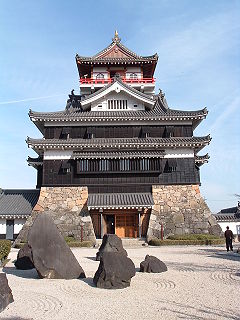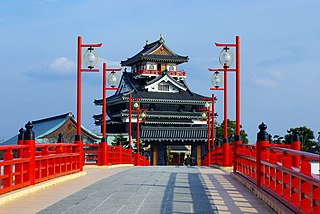Oda Nobutomo(織田 信友, ? – 10 May 1555) was a Japanese warlord during the Sengoku period. He was head of the Kiyosu Oda faction of the Oda clan, and ruled the four southern districts of Owari Province as shugodai .

The Sengoku period is a period in Japanese history marked by social upheaval, political intrigue and near-constant military conflict. Japanese historians named it after the otherwise unrelated Warring States period in China. It was initiated by the Ōnin War, which collapsed the Japanese feudal system under the Ashikaga shogunate, and came to an end when the system was re-established under the Tokugawa shogunate by Tokugawa Ieyasu.

The Oda clan was a family of Japanese daimyōs who were to become an important political force in the unification of Japan in the mid-16th century. Though they had the climax of their fame under Oda Nobunaga and fell from the spotlight soon after, several branches of the family continued as daimyō houses until the Meiji Restoration.

Owari Province was a province of Japan in the area that today forms the western half of Aichi Prefecture, including the modern city of Nagoya. The province was created in 646. Owari bordered on Mikawa, Mino, and Ise Provinces. Owari and Mino provinces were separated by the Sakai River, which means "border river." The province's abbreviated name was Bishū (尾州).
Contents
After Oda Nobuhide died in 1551, Nobuhide's son Nobunaga was initially unable to assume control of the entire clan. Nobutomo challenged Nobunaga for control of Owari in the name of Owari's shugo , Shiba Yoshimune, technically his superior but in reality his puppet. After Yoshimune revealed to Nobunaga an assassination plot in 1554, Nobutomo had Yoshimune put to death. The next year, Nobunaga took Kiyosu Castle and captured Nobutomo, forcing him to commit suicide not long after.
Oda Nobuhide was a warlord and magistrate of lower Owari Province during the Sengoku period of Japan. His father was Oda Nobusada and Nobuhide was the father of Oda Nobunaga.

Oda Nobunaga was a powerful daimyō of Japan in the late 16th century who attempted to unify Japan during the late Sengoku period, and successfully gained control over most of Honshu. Nobunaga is regarded as one of three unifiers of Japan along with his retainers Toyotomi Hideyoshi and Tokugawa Ieyasu. During his later life, Nobunaga was widely known for most brutal suppression of determined opponents, eliminating those who by principle refused to cooperate or yield to his demands. His reign was noted for innovative military tactics, fostering free trade, and encouraging the start of the Momoyama historical art period. He was killed when his retainer Akechi Mitsuhide rebelled against him at Honnō-ji.
Shugo (守護) was a title, commonly translated as "(military) governor", "protector" or "constable", given to certain officials in feudal Japan. They were each appointed by the shōgun to oversee one or more of the provinces of Japan. The position gave way to the emergence of the daimyōs in the late 15th century, as shugo began to claim power over lands themselves, rather than serving simply as governors on behalf of the shogunate.








